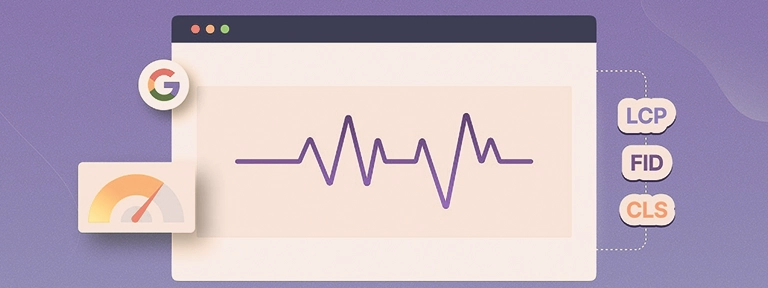Core Web Vitals Crucial Tips to Optimize Site Performance
Website performance has now become one of the most vital factors in determining digital success. With Google’s emphasis on visitor experience, Core Web Vitals is the one that plays a very important role in search engine rankings. A site that loads slowly or experiences downtime anytime can result in increased bounce rates, and decreased lead conversions.
For both organizations and site owners, understanding and improving Core Web Vitals becomes important. This blog covers Core Web Vitals, their influence on SEO rankings, and useful strategies to boost site performance.
About Core Web Vitals
Core Web Vitals are a group of different criteria established by Google to check real-time visitor experience across sites. These criteria centered on three essential segments:
- Largest Contentful Paint (LCP) – Checks loading performance by easily tracking how rapidly the biggest visible element (such as text block or an image) loads.
- Interaction to Next Paint (INP) – Checks responsiveness by evaluating how quickly a page replies to visitor interactions.
- Cumulative Layout Shift (CLS) – Tracks visual stability by checking how much a page shifts unexpectedly during loading.
A site enhanced for all these metrics offers a quicker, more balanced, and more responsive experience to visitors.
Why Core Web Vitals Is Essential for SEO
Google utilizes Core Web Vitals as an essential part of its algorithm related to ranking. Sites that offer a seamless, quick, and visually stable experience rank well in search engine result pages, resulting in increased organic traffic and user engagement.
Bad Core Web Vitals scores can badly impact SEO rankings, boost bounce rates, and reduce conversions. This makes it necessary for organizations to improve their websites.
How to Measure Core Web Vitals

You can simply test your Core Web Vitals performance with the help of various tools such as:
- Google Core Web Vitals Test (PageSpeed Insights)
- Chrome User Experience Report (CrUX)
- Google Search Console (Core Web Vitals Report)
- Lighthouse
By checking all these reports, you can classify areas where your site needs more improvement.
Read Also: GPU Dedicated Server for smooth website performance
Optimizing Core Web Vitals for Website Performance
Enhancing Largest Contentful Paint (LCP)
Largest Contentful Paint (LCP) checks how long it takes for the biggest visible element to load. Mainly, LCP should be almost or less than 2.5 seconds.
How to enhance LCP:
- Utilize a Reliable Web Hosting Service
Selecting a trustworthy hosting service provider such as Infinitive Host offers high-speed performance. Their web hosting services and VPS (Virtual Private Server) services provide minimum latency and boosted data processing, decreasing LCP time.
2. Optimize Videos & Images
Compress huge images utilizing the WebP format and serve images with the help of a Content Delivery Network (CDN) to increase delivery.
3. Reduce Render-Blocking Assets
Decrease the number of JS and CSS files that slow down page rendering. Lessening and uniting these assets helps enhance LCP.
4. Enable Lazy Loading
Slow down the loading of unwanted images until they are required, enhancing early page speed.
Improving Interaction to Next Paint (INP)
Interaction to Next Paint (INP) is a more important benchmark for responsiveness as compared to First Input Delay (FID). It checks how rapidly any page responds to visitors’ interactions, like clicking any specific button or filling out a form.
How to Optimize INP:
- Reduce Third-Party Scripts
A lot of external scripts (for example, analytics, advertisements, and social media widgets) can easily slow down responsiveness. Have only the required ones.
2. Utilize a Performance-Optimized Hosting Service Provider
Infinitive Host’s VPS hosting service can offer flawless user interactions by lessening server response time.
3. Optimize JavaScript Execution
Reduce needless JS execution time by simply removing unwanted scripts and utilizing code-splitting methods.
Reducing Cumulative Layout Shift (CLS)
Cumulative Layout Shift (CLS) checks how much content shifts unpredictably as a webpage loads. An excellent CLS score is less than 0.1.
How to Improve CLS:
- Define Image & Video Dimensions
Make sure to mention height and width attributes for both videos and images to avoid unexpected shifts.
2. Prevent Dynamic Advertisements Without Space Reservation
Advertisements that load nonsimultaneously can lead to complete layout shifts. Save some space, especially for them, in your layout.
3. Utilize Web Fonts Productively
Bad font loading can lead to shifts when alternative fonts are effortlessly replaced by Google Web Fonts or some other tailored fonts. Utilize the best web fonts enhanced for performance.
Several Other Essential Website Performance Strategies

Select the Right Web Hosting Service Provider
Web hosting is the one that always plays an important role in the case of Core Web Vitals optimization. A quick and trustworthy hosting service provider offers minimum latency and rapid server response times.
- Infinitive Host’s web hosting services offer powerful infrastructure for sites, enhancing load times and visitor experience.
Improve for Mobile Performance
Since almost half of the website traffic comes from smartphone users, make sure that your website is mobile-friendly with good design and quick-loading factors.
Use a Content Delivery Network (CDN)
A CDN allocates your content across different locations globally, decreasing the distance between the server and the user, resulting in improved load times.
Apply Browser Caching
Use browser caching to store static files locally, minimizing load times for returning site visitors.
Lessen HTTP Requests
A lot of unnecessary HTTP requests sometimes slow down page loading. Remove unwanted requests by removing massive images, JS, and CSS files.
Conclusion
Optimizing Core Web Vitals is very important for search engine optimization, visitor experience, and business growth. A quickly loading, balanced, and responsive site offers good SEO rankings, reduced bounce rates, and increased conversions.
To boost your site’s performance:
- Optimize Interaction to Next Paint (INP) by improving JS and removing unnecessary third-party scripts.
- Decrease Cumulative Layout Shift (CLS) by properly describing dimensions for images and utilizing the best strategies for fonts and advertisements.
- Improve Largest Contentful Paint (LCP) by enhancing images and selecting quick web hosting.
Selecting the best web hosting service provider, such as Infinitive Host, can significantly boost site speed and scalability. Their VPS hosting and web development solutions offer the powerful infrastructure to have high performance.
By obeying all these practices, you can be an expert in Core Web Vitals and make a site that ranks well, loads quickly, and provides a flawless user experience.
Read Also: GPU Hosting
FAQ
- What are Core Web Vitals?
Core Web Vitals are basically key factors of Google that check site performance, consisting of loading speed, responsiveness, and visual stability.
2. How to improve Core Web Vitals?
Improve images, utilize a quick web hosting service provider, decrease render-blocking resources, and enable lazy loading.
3. How to fix Core Web Vitals?
Check issues with the help of PageSpeed Insights, enhance LCP, INP, and CLS, and reduce JavaScript (JS) execution.
4. Does Core Web Vitals affect SEO?
Yes, Google considers Core Web Vitals a highly essential ranking factor, influencing site visibility and search performance.
5. How to check Core Web Vitals?
Utilize tools such as PageSpeed Insights, Google Search Console, and many more.
6. What are Google’s Core Web Vitals?
- Largest Contentful Paint (LCP) – Checks website loading speed
- Interaction to Next Paint (INP) – Evaluates responsiveness
- Cumulative Layout Shift (CLS) – Checks visual stability
7. What are Core Web Vitals (CWV) Metrics?
LCP, INP, and CLS are essential Core Web Vitals that boost visitors’ experience on a page.
8. How to improve Largest Contentful Paint (LCP)?
Utilize a CDN, enhance images, upgrade to powerful web hosting, and allow browser caching.



